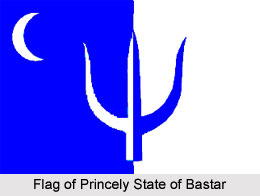 Princely State of Bastar was one of the major princely states of India that was established by Annama Deva during the early 14th century. He was the brother of Pratapa Rudra Deva, the Kakatiya king Warangal (Andhra). Bastar state was included as a part of the Central Provinces and Berar during the early 19th century and came under the control of the British Empire in India. The princely was acceded state was acceded to the Union of India, also known as Dominion of India on 1st January 1948 and was merged with the territory of Madhya Pradesh in 1956. Later in the year 2000, the region became a part of the Bastar district of Chhattisgarh state. The princely state of Bastar was located in the south eastern corner of the Central Provinces and Berar, which was bordered by the Kanker State in the north, the Godavari district of Madras States Agency in the south, the princely state of Hyderabad, Chanda District, and the Godavari River in the west and by the Jeypore estate in Orissa in the east.
Princely State of Bastar was one of the major princely states of India that was established by Annama Deva during the early 14th century. He was the brother of Pratapa Rudra Deva, the Kakatiya king Warangal (Andhra). Bastar state was included as a part of the Central Provinces and Berar during the early 19th century and came under the control of the British Empire in India. The princely was acceded state was acceded to the Union of India, also known as Dominion of India on 1st January 1948 and was merged with the territory of Madhya Pradesh in 1956. Later in the year 2000, the region became a part of the Bastar district of Chhattisgarh state. The princely state of Bastar was located in the south eastern corner of the Central Provinces and Berar, which was bordered by the Kanker State in the north, the Godavari district of Madras States Agency in the south, the princely state of Hyderabad, Chanda District, and the Godavari River in the west and by the Jeypore estate in Orissa in the east.
The state was spread across a total area of 33,830 sq km and comprised of a total population of 306,501 in the year 1901. Later in the year 1941, the population of the state was 633,888.The capital of the princely state of Bastar was Jagdalpur, which was located on the banks of Indravati River. The population of Jagdalpur was 4,762.
History of Princely State of Bastar
The princely state of Bastar was founded during 1324 AD, by Annama Deva, the brother of Pratapa Rudra Deva, who was the last Kakatiya King. Annama Deva reigned over the region until 1369 and was succeeded by Hamir Deva (1369- 1410), Bhaitai Deva (1410- 1468), Purushottama Deva (1468- 1534) and Pratapa Raja Deva (1602- 1625). After this the dynasty of the Bastar branch became extinct during the 3rd generation with Dikpala Deva (1680- 1709). Later in 1709, Rajapala Deva, a descendant of the younger brother of Prataparaja Deva, was appointed as the next ruler. In 1731, Dalapati Deva, the son of Rajapala Deva, ascended the throne of Bastar state. The capital of the state was at Jagdalpur, where the Bastar royal palace was constructed by the ruler.
During the 15th century, Bastar was segmented into 2 kingdoms, one based in Jagdalpur and the other ruled from Kanker. Until 18th century, the princely state remained rather independent until the rise of the Marathas. In the year 1861, Bastar state was included as a part of the newly created Central Provinces and Berar. In 1863, after an extended of feud over the region of Kotapad, it was provided to the adjoining state of Jeypore. This was done on the condition of a lump sum payment of tribute and two-thirds of the sum was remitted from the amount payable by the princely state of Bastar. The 20th and the last ruler of the Bastar state, Pravir Chandra Bhanj Deo, ascended to the royal throne in the year 1936. Later it was acceded to Dominion of India in the year 1948 during the Indian political integration. His Highness Maharaja Pravir Chandra Bhanj Deo was greatly admired by the tribals. He was shot dead while leading a tribal movement in the state of Bastar on 25th March 1966.
After the unfortunate incident, several tribals of the region began to move to Andhra in order to escape the harsh treatment of the local police, with the support of the outsiders. Due to the continuous Police violence and socio-cultural aggravation and harassment by the outsiders, who settled in the territory, the migration gained pace. Further more, there has been a steady decline in the tribal and native populations as a percentage of the total population.






































